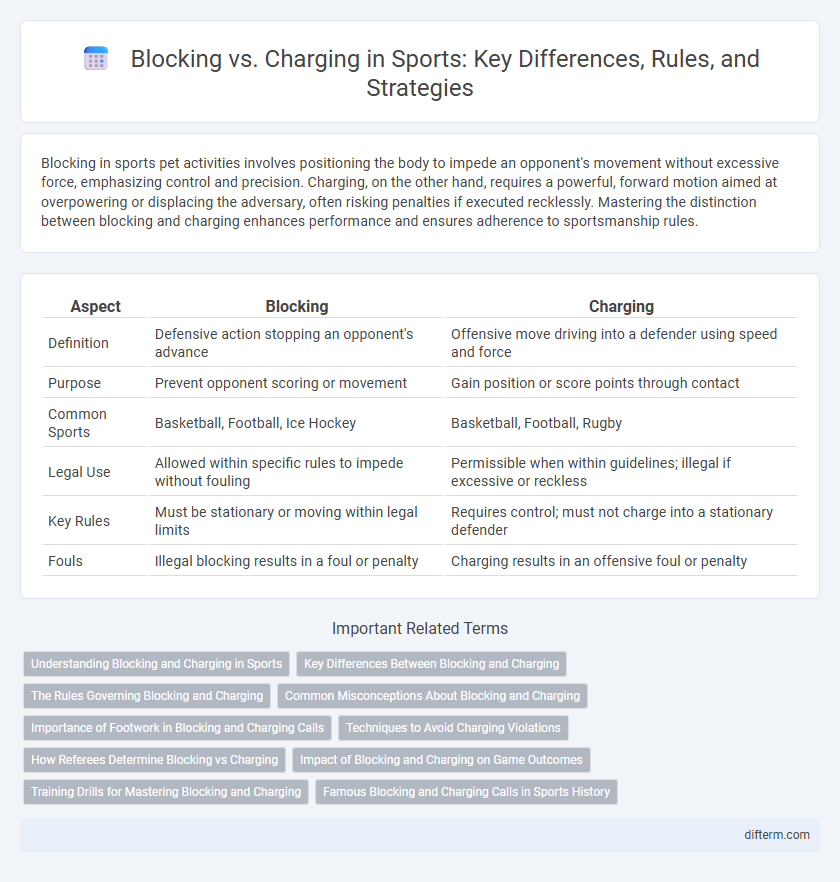Blocking in sports pet activities involves positioning the body to impede an opponent's movement without excessive force, emphasizing control and precision. Charging, on the other hand, requires a powerful, forward motion aimed at overpowering or displacing the adversary, often risking penalties if executed recklessly. Mastering the distinction between blocking and charging enhances performance and ensures adherence to sportsmanship rules.
Table of Comparison
| Aspect | Blocking | Charging |
|---|---|---|
| Definition | Defensive action stopping an opponent's advance | Offensive move driving into a defender using speed and force |
| Purpose | Prevent opponent scoring or movement | Gain position or score points through contact |
| Common Sports | Basketball, Football, Ice Hockey | Basketball, Football, Rugby |
| Legal Use | Allowed within specific rules to impede without fouling | Permissible when within guidelines; illegal if excessive or reckless |
| Key Rules | Must be stationary or moving within legal limits | Requires control; must not charge into a stationary defender |
| Fouls | Illegal blocking results in a foul or penalty | Charging results in an offensive foul or penalty |
Understanding Blocking and Charging in Sports
Blocking in sports involves a defensive player legally impeding an opponent's progress without initiating significant contact, whereas charging occurs when an offensive player aggressively drives into a stationary defender. Recognizing the distinction between blocking and charging is essential for referees to enforce rules correctly and maintain player safety. Proper understanding of these actions helps players execute strategic moves while avoiding fouls that can alter the flow of the game.
Key Differences Between Blocking and Charging
Blocking occurs when a defensive player legally impedes an offensive player's progress by establishing position before contact, typically resulting in no foul or a defensive foul if illegal. Charging happens when an offensive player with the ball runs into a stationary defender who has established legal position, often leading to an offensive foul. The key difference lies in who initiates illegal contact: blocking penalizes defenders for moving into or during contact, while charging penalizes offensive players for initiating contact into a set defender.
The Rules Governing Blocking and Charging
Blocking and charging are governed by specific rules in sports like basketball to ensure player safety and fair play. A blocking foul occurs when a defender impedes the progress of an offensive player without establishing a legal guarding position, while a charging foul is called when the offensive player runs into a defender who has already established position. The key distinction lies in the defender's position and movement; referees assess factors such as foot placement and body control to determine the appropriate call according to official league regulations.
Common Misconceptions About Blocking and Charging
Blocking and charging are distinct fouls in basketball often confused due to their physical nature, but blocking involves illegal defensive contact without establishing position, while charging occurs when the offensive player crashes into a defender with established position. A common misconception is that any contact by the defender is blocking, but the key factor is whether the defender has planted their feet and maintained position before contact. Understanding the difference improves officiating accuracy and helps players avoid unnecessary fouls during drives and screens.
Importance of Footwork in Blocking and Charging Calls
Footwork is critical in both blocking and charging calls as it determines player positioning and balance, directly impacting the referee's judgment. Precise foot placement helps defenders establish legal guarding position, reducing the risk of offensive fouls during charges. Efficient footwork enhances defensive agility, allowing quicker adjustments to offensive moves and improving overall defensive effectiveness.
Techniques to Avoid Charging Violations
Proper defensive positioning with feet set before contact is crucial to avoid charging violations in basketball. Maintaining verticality by keeping arms straight upward during a block helps defenders legally contest shots without initiating illegal contact. Anticipating offensive moves and establishing legal guarding position early reduces the risk of being called for charging fouls.
How Referees Determine Blocking vs Charging
Referees determine blocking vs charging by closely observing the defender's position and movement relative to the offensive player. A block is called when the defender establishes legal position before contact, while charging is assessed if the attacker initiates contact against a stationary defender. Officials analyze factors such as foot placement, timing, and body orientation to make accurate calls in real time.
Impact of Blocking and Charging on Game Outcomes
Blocking and charging fouls significantly influence game outcomes by affecting team momentum and scoring opportunities. Successful blocks disrupt offensive plays and can shift possession, while charging fouls often result in turnovers and free throws for the opposition. These violations alter player strategies and can decisively impact the final score in competitive sports.
Training Drills for Mastering Blocking and Charging
Training drills for mastering blocking and charging in sports emphasize agility, timing, and body control to reduce fouls and enhance defensive skills. Effective drills include one-on-one contact simulations, reaction time exercises, and controlled scrimmages that mimic in-game scenarios. Consistent practice in these drills helps athletes develop spatial awareness and proper positioning critical for differentiating between a legal block and an offensive charge.
Famous Blocking and Charging Calls in Sports History
Famous blocking and charging calls in sports history have often altered the outcomes of critical games, with referees' interpretations sparking intense debate among fans and analysts. Notable instances include the 2019 NBA Finals Game 7, where a controversial charging call against Draymond Green shifted momentum and influenced the Golden State Warriors' defensive strategy. These pivotal decisions highlight the importance of rule enforcement in maintaining fairness while showcasing how split-second judgments can become defining moments in sports legacy.
Blocking vs Charging Infographic

 difterm.com
difterm.com